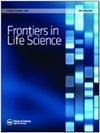Comparison of chlorophyll content in greenhouse tomato and cucumber leaves after HBED-Fe and EDDHA-Fe applications
Q1 Biochemistry, Genetics and Molecular Biology
引用次数: 6
Abstract
ABSTRACT Iron is an essential micro-element for plant growth. In the calcareous soils of Lebanon, immobilization of iron can lead to chlorosis and reduce the yields of agricultural production. Iron fertilization is therefore crucial to ensure good plant growth. The objective of this work was to compare the efficiency of the iron chelate HBED-Fe to that of EDDHA-Fe, on tomato (Solanum lycopersicum L.) and cucumber crops (Cucumis sativus L.). Five modules were studied in two separate greenhouses: one control, one module with fertilization by EDDHA-Fe and three modules with different applications of HBED-Fe. Chlorophyll and Fe contents in leaves were analyzed at different stages of the plants' cycle. Cucumber crops treated with HBED-Fe showed 19.2% higher chlorophyll content than the ones treated with EDDHA-Fe. Tomato crops presented 11.2% higher chlorophyll content when treated with HBED-Fe. For cucumbers, HBED-Fe should be applied in three applications separated by 25 days. For tomatoes, HBED-Fe should be applied in two applications separated by a month. The use of the HBED9% iron chelate was proved to be more effective than that of EDDHA6% because more efficiency was achieved with 40% less application rate. Multiple applications were also more effective than single applications.施用HBED-Fe和EDDHA-Fe后温室番茄和黄瓜叶片叶绿素含量的比较
铁是植物生长必需的微量元素。在黎巴嫩的钙质土壤中,铁的固定会导致黄化并降低农业生产的产量。因此,铁施肥对确保植物良好生长至关重要。本研究的目的是比较铁螯合物HBED-Fe和EDDHA-Fe对番茄和黄瓜作物的处理效率。在两个独立的温室中研究了五个模块:一个对照,一个用EDDHA-Fe施肥的模块和三个不同应用HBED-Fe的模块。分析了植物生长周期不同阶段叶片叶绿素和铁含量。HBED-Fe处理的黄瓜叶绿素含量比EDDHA-Fe处理的黄瓜叶绿素含量高19.2%。处理后番茄叶绿素含量提高11.2%。对于黄瓜,HBED-Fe应分三次施用,间隔25天。对于西红柿,HBED-Fe应分两次施用,间隔一个月。使用HBED9%的铁螯合剂比EDDHA6%的铁螯合剂更有效,因为在减少40%的施用量的情况下,效率更高。多个应用程序也比单个应用程序更有效。
本文章由计算机程序翻译,如有差异,请以英文原文为准。
求助全文
约1分钟内获得全文
求助全文
来源期刊

Frontiers in Life Science
MULTIDISCIPLINARY SCIENCES-
CiteScore
5.50
自引率
0.00%
发文量
0
期刊介绍:
Frontiers in Life Science publishes high quality and innovative research at the frontier of biology with an emphasis on interdisciplinary research. We particularly encourage manuscripts that lie at the interface of the life sciences and either the more quantitative sciences (including chemistry, physics, mathematics, and informatics) or the social sciences (philosophy, anthropology, sociology and epistemology). We believe that these various disciplines can all contribute to biological research and provide original insights to the most recurrent questions.
 求助内容:
求助内容: 应助结果提醒方式:
应助结果提醒方式:


